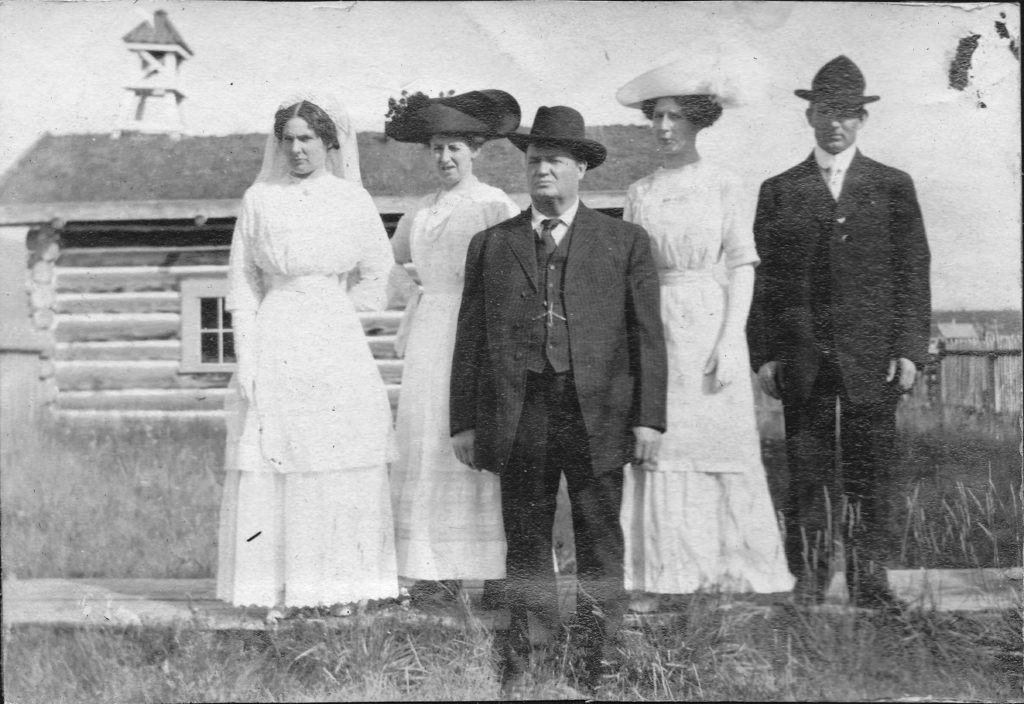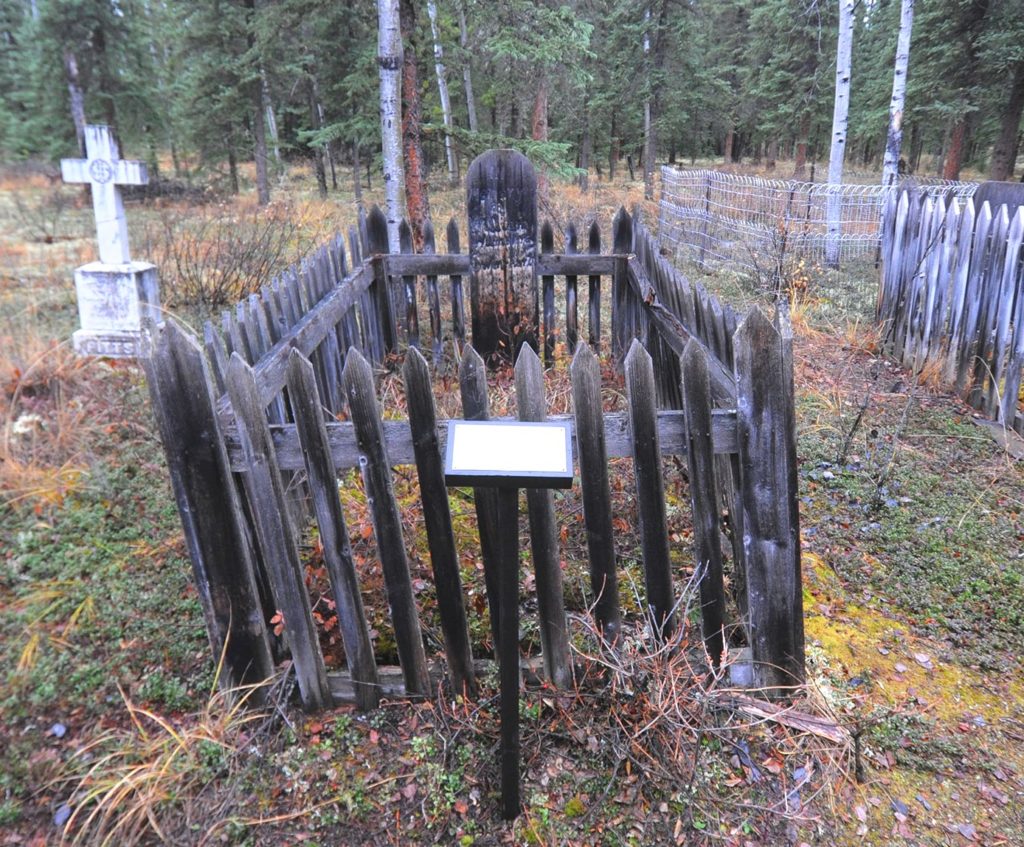The Swinehart Farm – part 4
The family reunites (1901 – 1911)
The establishment of the Swinehart Farm at Fort Selkirk may have provided the stable base to bring William Swinehart and his children back together again. William and his wife Rhoda had been raising their children in a settled life in rural Wisconsin when Rhoda died in 1889. In 1896, the family’s lives began to change even more dramatically when William and his son Guy went off to Juneau, Alaska. The older daughters Leta and Vivian followed sometime later and attended school in Juneau, with the youngest daughter Rhoda remaining behind in Wisconsin. This meant that the family was spread out between Wisconsin, Alaska and the Yukon during the last part of the 1890’s.
Leta returned to Wisconsin from Juneau at some point before 1900, but Vivian remained in Juneau and spent her middle teenage years separated from her family at the Sisters of St. Ann boarding school. In March of 1901, three years after William and Guy Swinehart had departed Juneau, Leta and Vivian, then aged 21 and 16, joined him at his Fort Selkirk farm.
The likely scenario for the young ladies’ trip to Fort Selkirk would have been an adventure, particularly for Leta. She presumably travelled by train from Wisconsin to Seattle, then by steamship to Juneau, where she met Vivian. The two would have journeyed together by boat to Skagway, boarded a train to Whitehorse on the newly-built White Pass & Yukon Route, then travelled on a riverboat down the Yukon River to Fort Selkirk to reunite with their father William, brother Guy and uncle Ham Kline.
Leta and Vivian eventually found husbands in Fort Selkirk. Newspapers in both Dawson and Juneau reported on Leta’s marriage at the Swinehart Farm on April 3, 1904 to Sgt. Edward Stillman of the North-West Mounted Police (NWMP). In October 1905, Vivian was married to George McLachlan, the telegraph operator at Fort Selkirk.
In 1905, Edward Stillman was charged by his employer, the NWMP, for selling government hay and then attempting to cover up his deed. He was dismissed from the force, which may have caused he and Leta to move to Dawson City, where in 1908 he was working as a timekeeper for the Guggenheim mining syndicate. In 1911 Vivian and her husband George McLachlan also moved from Fort Selkirk to Dawson City when George became a telegraph operator there.
In June 1908, the Swineharts became involved in one of the Yukon’s more notorious murder cases, that of Ned Elfors. About 20 kilometers downstream of Fort Selkirk, Elfors shot one travel companion in cold blood and severely wounded the other, Emil Anderson, who managed to escape. Anderson found his way to the Selkirk cut-off road, on which he encountered William Swinehart not far from his farm. Swinehart brought Anderson to his daughter Leta Stillman’s house in Fort Selkirk, where Leta and her sister Vivian McLachlan dressed his wounds. Elfors was captured soon after, and William, Leta and Vivian all had to travel to Dawson City to testify at his trial the following month.
Also in June 1908, a somewhat lighter story appeared in the Dawson Daily News when seeds William Swinehart had ordered from Toronto did not arrive as expected. A letter of complaint he wrote to the post office appeared in the News, containing this amusing note: “one Toronto firm was filling orders through the mail all winter. Why, my daughters have been getting goods from that firm all winter. They have had two hats each this spring from Eaton’s”. Apparently even pioneer Yukon farming women require nice hats, and these may be ones that are in photographs of the Swinehart daughters at Fort Selkirk.
In early 1910, William Swinehart’s youngest daughter Rhoda, who had been left behind in Wisconsin with her grandparents, made the family complete by travelling to Fort Selkirk in a journey likely similar to that undertaken by Leta nine years previous. Rhoda appears to have made the trip alone, a 21-year old farm girl from Wisconsin travelling to the frontier of the Yukon. It is possible that she was seeing her father, brother and sisters for the first time in several years.
In the 1911 Canada Census, all of William Swinehart’s family, including his son and three daughters, one son-in-law and a future son-in-law, were shown to be present at the Fort Selkirk farm. Whether it was one big happy family is uncertain, but they were soon to start drifting apart once again.
The year after her arrival at Fort Selkirk, Rhoda married Alfred Ingrams from Montreal in July 1911. Her sisters Leta and Vivian, then living in Dawson City but in Fort Selkirk when the census was taken, were perhaps there preparing for Rhoda’s wedding. Within a week of the wedding, Alfred and Rhoda were already on their way out of the Yukon, bound for the Fraser Valley of British Columbia where they became engaged in berry farming.

In March 1912 in Dawson City, Leta gave birth to a daughter that she and Edward named Vivian Rhoda Stillman, after her two sisters. This was William Swinehart’s first grandchild and the only one he would ever be able to see.
End of the Swinehart Farm (1914) and life in the Yukon (1920’s)
In July 1914, the Swinehart Farm came to a crashing end when William Swinehart dropped dead at the age of 59 while working in his field. The cause was reported by newspapers to be heart disease, but it appears as apoplexy (a stroke) on his death registration. He was buried in the Yukon Field Force cemetery at the eastern end of Fort Selkirk. His grave is marked by a wooden headboard that is becoming difficult to read more than 100 years later, and recently his descendants had a brass plaque installed there as a more permanent marker.

(Joel LeBaron photo)
It appears that the Swinehart Farm was abandoned after William’s death. His daughters Leta and Vivian had been living in Dawson City for a few years and his son Guy, who had been at the farm with his father from the start, was also living in Dawson by the following year. Whether the Swinehart Farm was occupied or farmed by anybody afterwards is not certain, but if so it was not mentioned in oral history interviews that were carried out at Fort Selkirk in 1984 and ’85.
The three siblings remained in the Yukon for a few more years before eventually leaving for California. It appears that Vivian was the first to leave after her marriage to George McLachlan ended, and by 1924 she was living in California.
Leta and Edward Stillman had another daughter, Rhoda Jane, born in 1915 in Dawson City, then in 1917 Edward died at the age of 46, leaving Leta a widow with two young daughters. In 1921, Leta married George Pohl in Dawson City in “a wedding remarkable in the history of the Yukon and probably without precedent elsewhere”, in reference to Leta’s and George’s positions in their respective lodges, the Rebekahs and the Oddfellows. The ‘historic wedding’ didn’t make for a long marriage, however, and in 1924 Leta and her daughters left for California.
Guy Swinehart remained the longest in the Yukon, but not for too long after his sisters left. In 1915, the year after his father died, he was listed as a miner at Dawson City, and also worked that fall as a horse wrangler and big game guide in the upper White River area. In 1916, Guy began working as a telegraph operator, spending most of his telegraph career at Ogilvie (located on the Yukon River upriver from Dawson City), with occasional stints at other stations including Fort Selkirk. The Yukon River break-up of 1925 caused extensive damage and swamped the Ogilvie station, forcing Guy to spend three days on the roof of the office, where he built a fire and subsisted on soda crackers and tea. Guy left the Yukon in that fall of 1925 and by 1927 he was living in California, reunited with his sisters.
The youngest Swinehart daughter, Rhoda, who with her husband Alfred Ingrams had moved from the Yukon to BC in 1911, later moved on to Montreal. After Alfred died there in 1943, Rhoda and her daughter moved to California to join her siblings, who had lived there since the mid-1920’s. They all stayed there for the rest of their days; Guy died in 1949, Leta in 1959, Rhoda in 1964, and Vivian in 1970.
The story of William Swinehart and his children being separated and then reunited at various points during their lifetimes may be an exceptional example of family cohesion, despite circumstances pulling them apart. From Wisconsin to Juneau to Fort Selkirk to California, the Swineharts seemed to continually feel the pull of family bonds throughout their lives.
Updated October 7, 2023